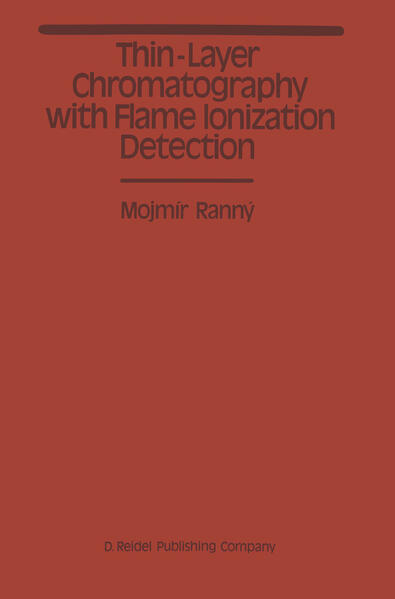Thin-layer chromatography (TLC) has become a common and much favoured separation technique in laboratories in widely varied fields in recent years. Much of the credit for the introduction of this technique into analytical practice at the l 2 end of the 1950s is due to E. Stahl - - This method is simple and is characterized by high separation ability and sufficient sensitivity3; however, some analysts feel that it has passed the peak in its development and will gradually be replaced by the more modem high-performance liquid chromatography (HPLC). This is undoubtedly a very important analytical technique utilizing the specific separa tion properties of a large number of sorbents and the possibility of regulating 4 the flow-rate of the mobile phase by adjusting the pressure - Standardization of the experimental conditions is simpler in HPLC than in TLC, where the activity of the sorbent and flow-rate of the eitlent in the thin layer depend markedly on the relative humidity of the laboratory atmosphere and on the composition of the gaseous phase in the elution chamber. In addition, systems for quantitative detection of the separated ~ones are better developed for HPLC than for classical TLC, where, until recently, cumbersome and often even insufficiently reproducible chemical or gravimetric analysis of the extracts of scraped-off spots or densitometry of the separated zones, located first by pyrolysis or reaction s with suitable detection agents, were the predominant determination methods .
Inhaltsverzeichnis
1 General and Methodical.- 1.1 Principles of Thin-Layer Chromatography and Basic Quantities in the Chromatographic Process.- 1.1.1 Distribution of the Solute Between the Stationary and Mobile Phases; the Retardation Factor.- 1.1.2 Flow of the Liquid Phase Through the Layer.- 1.1.3 The Effect of Diffusion on the Zone Resolution.- 1.1.4 The Theoretical Plate; Resolution; Separation Number.- 1.2 Methods of Thin-Layer Chromatography with Flame Ionization Detection (TLC-FID).- 1.2.1 A Short Description of the TLC-FID Procedure.- 1.2.2 The TLC-FID Technique.- 1.2.2.1 The System for Detection in the FID.- 1.2.2.2 Recorders and Electronic Integrators.- 1.2.2.3 Accessories for Application, Elution and Drying of Thin Layers.- 1.2.2.4 Chromarods.- 1.2.3 Operational Parameters and Procedures.- 1.2.3.1 Preparation of Chromarods for Analysis.- 1.2.3.2 Application of the Analysed Mixture to the Rods.- 1.2.3.3 Elution Solvents.- 1.2.3.4 Elution.- 1.2.3.5 Drying of the Eluted Rods Prior to Detection.- 1.2.3.6 Flame Ionization Detection.- Hydrogen and Air Flow-Rates.- Detector Geometry and Scanning Rate.- The Effect of the Composition of the Analysed Sample.- 1.2.3.7 Methods for Quantitative Evaluation of the Results of TLC-FID Analyses.- The Internal Normalization Method.- The Absolute Calibration Method.- The Internal Standard Method.- 1.2.3.8 Reproducibility in TLC-FID.- 2 Specialized Applications.- 2.1 Applications in Biology, Medicine and Pharmacy.- 2.1.1 Lipids and Related Substances.- 2.1.1.1 Isolation of Lipids from Biological Materials.- 2.1.1.2 Chromatography on Chromarods.- 2.1.1.3 FID Reproducibility and Response.- 2.1.1.4 Applications.- 2.1.2 Steroid Compounds.- 2.1.3 Vitamins.- 2.1.4 Alkaloids and Purine Bases.- 2.1.5 Amino Acids.- 2.1.6 Terpenes and Resins.- 2.1.7 Psychotropic Substances.- 2.1.8 Antipyretics, Analgesics and Hypnotics.- 2.1.9 Antibiotics.- 2.1.10Sulphonamides and Sulphanilic Acid.- 2.1.11Polyamines.- 2.2 Applications in the Food Industry and Related Fields.- 2.2.1 Fats, Oils and Related Substances.- 2.2.2 Phospholipids.- 2.2.3 Saccharides.- 2.2.4 Food Additives.- 2.2.5 Cosmetics.- 2.3 Applications in the Chemical Industry and Related Fields.- 2.3.1 Surfactants and Detergents.- 2.3.2 The Petroleum Industry and Related Fields.- 2.3.3 The Industrial Production of Technical Emulsions for the Metal, Textile and Leather Industries.- 2.3.4 The Polymer Industry.- 2.3.5 Pesticides and Growth Regulators.- Par 3 New Perspectives in TLC on Chromarods.- 3.1 Increasing the Reproducibility and Sensitivity of the Determination.- 3.2 New Detection Systems.- 3.3 New Model of the Iatroscan.- References.










